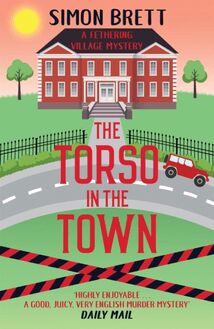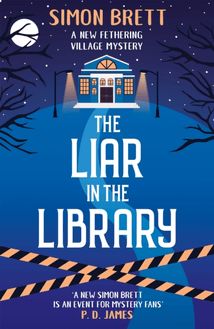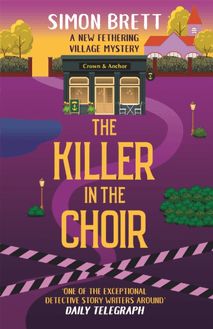Death on the Downs , livre ebook
172
pages
English
Ebooks
2019
Vous pourrez modifier la taille du texte de cet ouvrage
Obtenez un accès à la bibliothèque pour le consulter en ligne En savoir plus
Découvre YouScribe en t'inscrivant gratuitement
Découvre YouScribe en t'inscrivant gratuitement
172
pages
English
Ebooks
2019
Vous pourrez modifier la taille du texte de cet ouvrage
Obtenez un accès à la bibliothèque pour le consulter en ligne En savoir plus
Publié par
Date de parution
06 juin 2019
Nombre de lectures
0
EAN13
9781786897732
Langue
English
Publié par
Date de parution
06 juin 2019
Nombre de lectures
0
EAN13
9781786897732
Langue
English
Simon Brett worked as a producer in radio and television before taking up writing full-time. He was awarded an OBE in the 2016 New Year’s Honours ‘for services to literature’ and also was elected a Fellow of the Royal Society of Literature. In 2014 he won the CWA’s prestigious Diamond Dagger for an outstanding body of work. simonbrett.com
Also by Simon Brett
The Fethering Mysteries The Body on the Beach The Torso in The Town Murder in the Museum The Hanging in the Hotel The Witness at the Wedding The Stabbing in the Stables Death Under the Dryer Blood at the Bookies The Poisoning in the Pub The Shooting in the Shop Bones Under the Beach Hut Guns in the Gallery Corpse on the Court The Strangling on the Stage The Tomb in Turkey The Killing in the Cafe The Liar in The Library
The Charles Paris Theatrical Series Dead Room Farce A Decent Interval The Cinderella Killer
The Mrs Pargeter Mysteries Mrs Pargeter’s Point of Honour Mrs Pargeter’s Principle Mrs Pargeter’s Public Relations
Short stories A Box of Tricks Crime Writers and Other Animals
First published in Great Britain, the USA and Canada in 2019 by Black Thorn, an imprint of Canongate Books Ltd, 14 High Street, Edinburgh EH1 1TE
This digital edition first published in 2019 by Black Thorn, an imprint of Canongate Books
First published in 2001 by Macmillan Publishers Ltd, Pan Macmillan, 20 New Wharf Road, London N1 9RR
blackthornbooks.com
Copyright © Simon Brett, 2001
The moral right of the author has been asserted
This is a work of fiction. Names, characters, places and incidentsare either the product of the author’s imagination or are used fictitiously. Except where actual historical events and characters are being described for the storyline of this novel, all situations in this publication are fictitious and any resemblance to actual persons, living or dead, business establishments, events or locales is purely coincidental
British Library Cataloguing-in-Publication Data A catalogue record for this book is available on request from the British Library
eISBN 978 1 78689 773 2
To Priscilla
Contents
Chapter 1
Chapter 2
Chapter 3
Chapter 4
Chapter 5
Chapter 6
Chapter 7
Chapter 8
Chapter 9
Chapter 10
Chapter 11
Chapter 12
Chapter 13
Chapter 14
Chapter 15
Chapter 16
Chapter 17
Chapter 18
Chapter 19
Chapter 20
Chapter 21
Chapter 22
Chapter 23
Chapter 24
Chapter 25
Chapter 26
Chapter 27
Chapter 28
Chapter 29
Chapter 30
Chapter 31
Chapter 32
Chapter 33
Chapter 34
Chapter 35
Chapter 36
Chapter 37
Chapter 38
Chapter 39
Chapter 40
Chapter 41
Chapter 42
Chapter 43
Chapter 44
Chapter 45
Chapter 46
Chapter 47
Chapter 48
Chapter 49
Chapter 50
Chapter 51
Chapter One
The bones didn’t look old, but then what did Carole Seddon know about bones? Her work at the Home Office had brought her into contact with forensic pathologists from time to time, but she didn’t lay claim to any of their arcane knowledge. She was just an ordinary member of the public – in retirement an even more ordinary member of the public.
But any member of the public who’d done the rudiments of anatomy at school, who’d watched television or been to the cinema, would have recognized that the bones were human.
Carole saw them as she picked herself up off the floor of the barn. When she had realized the rain showed no immediate signs of relenting, she had tried to make herself comfortable on a pile of roughly cut planks. They were dark green with the slime of ages, but her trousers and Burberry raincoat were already so mud-spattered and wet that more dirt would make little difference. She planned to spread out a newspaper over the immaculate upholstery of her Renault when she got back to the road where it was parked.
Maybe it was the slime, maybe it was the fact that they had recently been moved, but the planks proved an unstable seat. When Carole had put her full weight on them, they had tipped forward, spilling her unceremoniously on to the hard earth floor of the barn. Their collapse revealed the bright blue fertilizer bags, out of one of which protruded the unmistakable ball-joint of a human femur.
The barn was not on one of Carole Seddon’s regular walking routes. Indeed, she rarely went on to the Downs. Gulliver, her dog, was too easily distracted up there, overexcited by the smells of cattle, rabbits and other smaller but infinitely intriguing species of wildlife. Given the luxury of all that space, it would have been cruel to keep the dog on a lead, but she didn’t trust him to return from his manic forays into the Downs. Despite impeccable Labrador breeding, Gulliver wasn’t a natural country dog. He was at home on Fethering Beach; he knew it well, and always returned safely to his mistress from quixotic tilts at seagulls, breakwaters or the fascinating detritus that the tide brought in. Carole even reckoned he could, if necessary, find his own way back from the beach to her cottage, High Tor, in Fethering High Street.
But a sortie on the beach was the reason why Gulliver wasn’t with his mistress that February afternoon on the Downs. The week before, with customary bravado, he’d attacked a seaweed-shrouded potential enemy, only to back off limping from a gash to his forepaw. His quarry had proved to be a rusty can with a jagged edge. An immediate visit to the vet, injections and bandaging had left Gulliver a mournful, housebound creature who snuffled piteously by the Aga, pressing his nose and teeth against the intransigent dressing on his leg. The bandages were swaddled in polythene to keep out the damp when he hobbled off with Carole on the essential toilet outings, which were the only social life the vet’s instructions allowed him for a fortnight.
That was why Carole was up on the Downs. Without Gulliver’s curiosity to worry about, she told herself positively, she had the freedom to roam. But in her heart she knew another reason for her choice of walking route. She was likely to meet fewer people on the Downs. In Fethering Gulliver was her prop. If she was seen walking alone on the beach, she might look as if she was lonely.
She had parked the Renault on the outskirts of Weldisham, a village on the foothills of the South Downs that looked from the outside as though it hadn’t changed much since the days when Agatha Christie might have set a murder there.
The squat tower of a Saxon church rose above the naked trees. There presumably the aristocracy, the gentry and the commonalty might meet, casting suspicious glances from pew to pew after the dirty deed had been done. In the village pub, the Hare and Hounds, old men with rough-hewn accents might become indiscreet over foaming pints of ale, letting drop conveniently vital clues.
Weldisham offered a couple of homes substantial enough to host house-parties at which crimes could be committed. A scattering of smaller dwellings might accommodate those local professionals – the doctor, the solicitor, the vicar – who didn’t quite cut the social mustard, but who could prove invaluable as suspects and witnesses.
There were two old barns in the village whose agricultural purpose was unspecified, but which would provide ideal venues for the discovery of the second murder victim, probably impaled by a pitchfork. And then there were small, flint-faced cottages to house the peasantry – the farm workers, the gardeners and the wheelwright – one of whose quaint dialect testimony would provide the final piece of the jigsaw, allowing the visiting sleuth to bring another malefactor to the unforgiving justice of the scaffold.
Though that was how Weldisham may still have looked to the uninformed observer, at the turn of the new millennium it housed a very different set of characters. The church looked no different, though its congregation could usually be counted without recourse to a third hand. And the Hare and Hounds, after many and varied refurbishments, was now owned by a chain whose corporate mission was ‘to maintain the authenticity and individuality of idiosyncratic country local hostelries’.
A few Estate cottages remained as Estate cottages, though the farm workers who lived in them these days drove in closed tractors with heaters and music systems. Manual workers not employed by the Estate couldn’t begin to afford Weldisham prices. The other cottages had been made over into bijou residences for the retired or for London-based weekenders. Solicitors and doctors, now rather higher up the social pecking order than they had been in Christie’s day, still inhabited the middle-range houses, from which they made their short commute to local offices and surgeries. Some hardened souls resolutely travelled up to London on a daily basis, their constant assertions that they had found ‘quality of life’ undermined by the fact that for half the year they left and arrived back at their country idylls in pitch blackness.
One of the barns in the village had been tastefully converted into a dwelling with large rooms, high ceiling and horrendous heating bills. The other, whose mangy thatch slid slowly from broken-backed rafters, remained unconverted and was the subject of continual planning applications. But each approach ended the same way. The Village Committee pointed out that the building was inaccessible behind other houses, and its residential use would necessitate the construction of a new road in Weldisham, which was bound to cause disruption to existing home owners. The barn was also too close to other dwellings; its use as a residential property could only cause a nuisance. So, despite the repeated efforts of the Estate and a sequence of developers who recognized its huge financial potential, the Village Committee stood firm. The planners, hyper-sensitive about press criticism of other blunders and eyesores in West Sussex, paid heed to their arguments and the barn continued its quiet decay.
Had it had a more visible profile in Weldisham, local p







